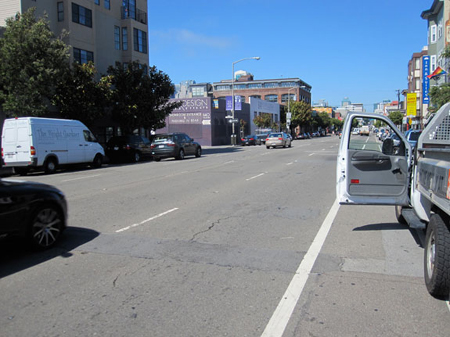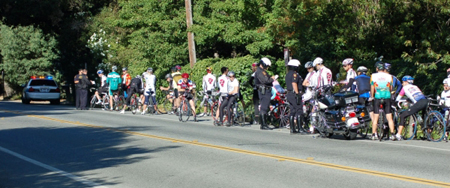Deadly Weapon
 Thu, June 30, 2011
Thu, June 30, 2011 
A couple of weeks ago I was out riding with two friends; we were on a two lane country road, traffic was light as it was early Sunday morning.
We were riding single file close to the right hand edge of the road when three vehicles approached from behind; it just so happened that there was an opposing vehicle there at the same time.
The leading car behind us decided to slow and wait for this single car in the opposite lane to pass before swinging wide to overtake us. This was proper behavior, they could have squeezed by without waiting, but this driver decided to take the safer approach.
I was the last in this trio of cyclists, also riding in a safe and courteous manner; I even gave the lead driver behind me a little thank you wave as he went past. The second car did the same, swinging wide to overtake us.
However, the third vehicle was a full size Chevy truck; he just laid on the horn and drove by as fast as he could and as close as he could; he missed us by about a foot. Totally unnecessary as the opposing lane was now clear.
This was intimidation with a deadly weapon, pure and simple; a “How dare you slow me down; I’ll teach you,” attitude.
If I could have spoken with this driver I would have asked, “Where are you going in such a hurry on a Sunday morning that you can’t stand to be delayed for two seconds?” Because I swear this whole maneuver took no longer. I would also have asked him this.
“If you had a loaded gun in your hand and you were mad at someone, would you fire it missing them by twelve inches just to intimidate them?”
I doubt most law abiding citizen would do that, including this driver. But the potential for death or serious injury are the same; I would describe it as ‘Assault with a deadly weapon.’
In fact I would go further and say, given the choice between taking a bullet and taking a hit from a full size Chevy truck, I would rate my chances of survival better if I took the bullet.
What is it about driving a large vehicle that gives one such a sense of entitlement? It seems it is always the driver of a full size truck or SUV that have this attitude; I rarely get the ‘Horn and Buzz’ treatment from anyone in an economy car.
This exact same scenario happened just this week in California; a driver of an SUV threatened a group of cyclists with his vehicle. They were able to take his tag number, flagged down a Sheriff’s Deputy, and reported it; the driver was traced and arrested for... Guess what? Assult with a deadly weapon.
I have to remember that; when I am riding on my own I usually ignore such behavior as it is just my word against another. But in the above instance I was with two friends, I had witnesses. I may be too old to kick ass, at least I can take numbers.


























Driving Around Cyclists for Dummies
“I thought you might be interested in AAA's stance on California's proposed law requiring a three foot passing distance of cyclists by motor vehicles.
I was surprised to discover that my auto insurance company was lobbying against the proposed law and asked them why."
Here is their response:
Thank you for your comments relative to AAA's position on SB 910.
Our official position is not a straight oppose, it is an 'oppose unless amended'. We don't take issue with the 3 foot distance rule when it can be safely accomplished. The problem is how to address situations when a 3 foot distance cannot be maintained or met.
Current language in the bill would require the vehicle to slow to 15 mph of the speed of the bicycle to pass. But this is problematic for several reasons, as pointed out in the bill analysis. Law enforcement has issues with this approach as well because it can cause a drastic decrease in speed differentials between the vehicle passing the bicycle and other vehicles on the road depending on the posted speed limit.
Not only can this cause rear-end collisions, it can create a more dangerous situation for the cyclists. It is the differences in speed that is the number one cause of car crashes. Another suggested approach is to require the car to enter into the opposite lane of traffic (cross a double line) in order to give the cyclists the 3 foot distance. This is something being explored as well as a number of other ideas.
While we can all agree on the concept and goal SB 910, crafting workable legislation usually requires addressing a number of details and issues that arise throughout the process as the concept is flushed out and enforceability is addressed.
The author of the bill, Senator Lowenthal, is committed to working with all interested parties, including law enforcement, AAA and the bicycle coalition sponsors of the bill to find the most appropriate and safest way to address situations, when the general rule to allow a 3 foot distance cannot be met due to road design. We have to determine what the law should be in those circumstances and there is some disagreement on that level.
Thank you again for allowing us to explain our position on the bill.
Best Regards,
Crista B. (AAA Northern California, Nevada and Utah.)
Thank you Keay for forwarding this; here is my take:
Why all the fuss over an issue that should be common sense. Would you pass any vehicle giving less than 3 foot of space? You would give a stray dog at least 3 feet when passing.
Let’s say there is a large object, a refrigerator for example, lying at the side of the road protruding 3 feet into your lane. Would you continue driving at 55 or 60mph and miss it by less than three feet?
Most sensible people would slow, and if they couldn’t go into the opposing lane, they would squeeze by carefully at a slow speed. The 3 foot passing law is calling for what people should do anyway if they were using common sense.
Let me offer another simple scenario: You are driving on any two lane highway or street; a vehicle is waiting to make a left turn. (Right turn in the UK.) The driver cannot make the turn because there is opposing traffic; he stops and waits with his turn signal on.
Other traffic stops and stacks up behind, waiting for the driver to make his turn. There is no danger, no one runs into the rear of anyone; eventually there is a break in opposing traffic, the vehicle makes its turn and everyone goes on their merry way.
And yet to read Crista B’s explanation above, a vehicle slowing because it is not safe to pass a cyclist presents a danger to other road users. I would suggest if a vehicle runs into the rear of another, they were driving too fast for the road conditions, or they were following too close. This is driving 101.
Maybe I should write a “Driving around cyclists for Dummies” book. In it I would say, “If you see a cyclists ahead give him/her plenty of room as you pass. If you can’t go into the opposing lane because there are cars coming the other way, slow down and wait for a break in opposing traffic.”
You only need a small break because a cyclist is about 7 foot long and 3 foot wide, usually traveling at 15 to 20mph; it is not like trying to pass an 18 wheel semi. And you don’t have to go completely over to the opposite lane but at least straddle the center line.
If I am that cyclist quite honestly I have no objections if you squeeze by with less than 3 feet, as long as you do so carefully at slow speed. If you bump me at 5mph over the speed I am doing it would probably not be too serious; but clip me at 55 or 60 and it might be fatal.
This 3 foot passing law is getting way too complicated for the average person to understand. Crista B for the AAA asks:
This situation is no different than a stop sign where cross traffic doesn’t stop. You stop, and then proceed when it is safe to do so. Legislators are not asked, “What do I do when it is not safe to proceed?” The answer is simple; you wait until it is safe. Give a cyclist 3 feet; if you can’t do that safely, then wait until you can.
No need to change the wording; if you slow down and pass a cyclist carefully no one is going to take a yard stick and argue over the exact 3 feet.
Imagine the cyclist is a refrigerator or some other large object in the road. Just slow down and go around while being careful not to bump into it.